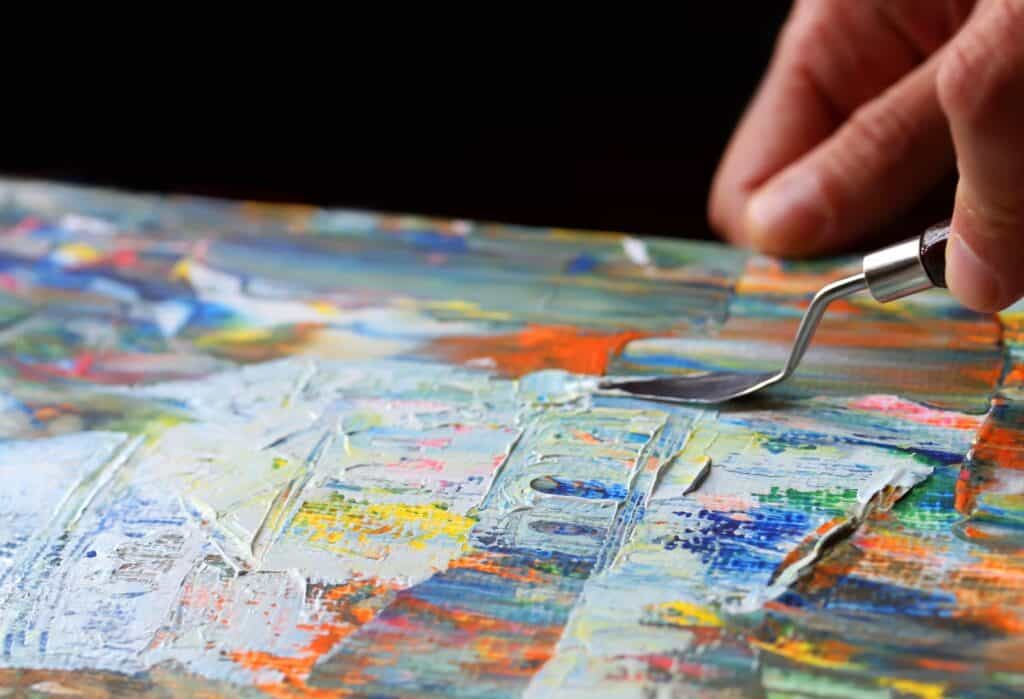In the age of digital everything, online selling has become one of the most reliable ways to sell products. There are training videos every business owner can watch to educate themselves– from creating something to selling them. But what if you've already created something physical, like a painting? Well, online is also a great place to market and sell physical products online as well. This article focuses on how to sell paintings online with success.
Opportunities are there for artists who want to showcase their work and sell their paintings online. More and more e-commerce platforms have enabled artists to target potential buyers directly rather than relying on galleries and exhibitions for exposure.
However, you will need a strategy to succeed in this niche. According to recent statistics, as of January 2022, 85% of surveyed art buyers said to have purchased art online in the previous 12 months.
But, as an artist yourself, you should know that selling your paintings online is so much more than taking a picture of your art, picking a platform, and crossing your fingers– hoping someone will find and buy it. It’s also about how you present them so you can attract potential buyers’ attention.

How to Sell Paintings Online: What You Need to Know
Before you jump into the process of selling your paintings online, you need to understand that there is a fundamental difference between selling your paintings at an exhibition and selling them online.
In exhibitions, you have a limited time frame and space to attract new buyers. However, you're able to interact and engage with potential customers in person and encourage them to make a purchase.
Meanwhile, when you sell your paintings online, you've got 24/7 access to potential buyers across the world and can utilize various marketing strategies to make the most of it. You can expect potential customers to be highly engaged online, but you must understand that this also means they will do their research before making an art purchase.
They have a lot of questions. Make sure you are ready to answer any questions they might have regarding your painting and its materials. This is a good way to earn their trust and make them feel more comfortable with making a purchase.
It’s also essential to give an immediate response as more than 82% of today’s consumers look for an immediate response from businesses.
Keep in mind that there are certain facts that potential buyers will check before buying your painting online. Knowing these facts will help you prepare an effective marketing strategy.
6 Tips on How to Sell Paintings Online
No matter how valuable and brilliant your arts are, when you fail to promote them online, it can be quite hard to sell them. So, here are some essential how-tos for selling paintings online in 2022 and beyond.
Tip #1. Understand Your Potential Buyers: Who Is It?
Let's start from the basics: With whom are you going to sell your paintings? Immerse yourself in your customers' world to better understand who they are and what kind of paintings they might love to have.
After all, not everyone on the internet understands the value of a painting, let alone buying it.
So, define your niche. Learn more about the potential buyers by asking questions like:
- Where do they live?
- What is their annual income?
- What types of art do they enjoy?
- What is their favorite painting?
Tip #2. Looks Matter: Invest In Professional Photos
Although online art sales have become more common, many potential buyers remain sceptical about buying art online. No one will buy your paintings if they can’t see what they look like.
You need to convince them that your paintings are worth their money. One of the best ways is to invest in professionally-taken photos. In today's digital age, we can say that the quality of the images you publish online could be the difference between a sale and no sale.
Smartphone cameras are often used by artists to take their art pictures and promote them. Well, it's quick and easy. But, if you want to make your paintings more eye-pleasing, you need to consider using professional gear.
Professional cameras, lighting kits, and professional editing can keep all the details, including colors and textures. In other words, they can represent your art accurately.
Here are some factors to consider when taking a professional photos for your paintings:
Lighting
Make sure to choose a location that has a soft, bright lighting. Too bright or harsh direct lighting can create reflections and shadows even shift the color of your paintings. You can set the ISO from 100 to 200, depending on the camera model you have.
Avoid using the flash from the camera as it can overpower the natural light. Decent window light is a go-to for natural light.
Angle
It's crucial to set your camera lens parallel with your paintings. So, if the painting needs to be on a slant to stand up, you need to tilt the camera to match the angle.
Also, consider using a tripod or a flat level surface as they are effective in creating sharp images.
Resolution
Leave only a small amount of space around the edges of your canvas on the frame. It helps you to maximize the resolution of the painting image you get on the camera.
Lenses aren't the sharpest when they're zoomed all the way out or in. That's why you might consider avoiding zooming as it reduces the image quality.
Background
It's always better to make your painting the only object in the photographs. That means using a clean, simple background is the best way to go– especially if you aim to show the details of the painting.
If you have no photography experience, you can hire professional photographers to do the job.
Tip #3. Pay Attention to the Photo Format
The photo format is important because it determines how much of your painting will be visible. It all depends on the painting itself. For example, if you use landscape canvas for the painting, position your camera horizontally to match the angle of the canvas.
To avoid any pixelation or blurriness, your painting photos should be a high quality .jpg or .png file measuring 1920px x 1000px up to a maximum file size of 2MB.
If your camera has the option, shoot in RAW + (Large) JPEG Format. This format will help you to get tons of necessary color information that makes the color editing process much easier. You can ensure what colors your potential buyers see on their screen match the true color of your painting.
Tip #4. Set the Right Price With Product Research
Selling your painting successfully is as much about pricing it appropriately as it is about marketing it. There are many factors that go into pricing your painting, including the size, the materials used, and the amount of time it took to make.
If you're a beginner artist, you might want to start with simple pricing. You can combine your time and labor costs with material costs and expenses. Then, add a small markup at the end to give yourself a profit. If you're a pro, you can set a premium price.
Either way, it's recommended that you do some product research. Find out how much other artists are selling their paintings for and determine whether your price is in the right range.

Tip #5. Provide the Information of the Painting
Some art buyers want more than just a pretty picture of your painting. They want to know more about it, such as:
- What it’s painted on
- What frame that is used
- What paint type or materials were used to create it
- How long it took to make
Since there is no gallery sales team to answer questions for them, make sure all your art has up-to-date and correct information.
Providing this information will help convince them that they’re getting a quality product. You can include the information on your painting in the description section of your online store.
To make the description or information more convincing, you can tell them in story-driven narratives as in creative writing.
Tip #6. Let Them Know Who You Are
Last but not least, let your customers know who you are. Remember that art buyers have extra-high expectations—so much so that they're often compared to buying a car or a house. You'll need to convince them that your paintings are worthy of their investment.
There may be some potential buyers who wonder about the artist behind the painting, or they may want to know more about you as a person.
Let them know where you are from, what kind of artwork you create, how long you have been painting, and what inspires you.

Wrapping Up: Sell Your Paintings Today
Selling your paintings online is a great way to make money from your art– but, what’s more, it can help you to share your craft and get noticed as an artist. Therefore, you’ll need to put in some effort to succeed. But, after hours of working on a painting, exhausted and up against a deadline and demand, many artista often neglect the most important part of the process: represent them online.
With those best practices above, now you understand that selling paintings online is more than utilizing e-commerce platforms. There are some other crucial aspects to consider when making the painting more valuable and worth every penny of the potential buyers.
Additional Painting Tip:
Artists should consider using lime paint. The Benefits of using Lime paint:
Lime paint holds a distinct allure in the realm of artworks due to its unique properties and benefits. Its velvety, matte finish and subtle texture contribute to an exceptional depth and luminosity in paintings, particularly in works that require a vintage or aged appearance. Lime paint's breathable nature allows it to interact with the underlying materials, creating a dynamic, evolving surface that artists can manipulate to their advantage.
FAQ
Q: How do I start selling my paintings online?
A: The best way to start selling your paintings online is by choosing the right platform, investing in professional images, and crafting compelling painting information.
Q: Do I have to spend an extra budget on professional images?
A: Though professional images of your paintings can make your painting more eye-pleasing and detailed, today’s smartphone cameras have great quality if you’re on a tight budget. One thing to keep in mind here is that you might want to spend extra effort on the editing process to make sure your painting photos just look as real as in real life.
Q: Do the best practices above apply on any platforms I’ll use?
A: Yes. There are tons of tips on how to sell your paintings online. But, those we mentioned above are the essential ones that you can follow– regardless of the platform or online galleries.
Q: How many photos should I take for my paintings to sell online?
A: A picture that shows your painting in a full frame is a must. You might as well take a picture of the texture of the painting you use by placing your camera a bit closer to the painting. This will help potential buyers see the detail much clearer. Take some shots even when you think that you got the best one when you see it on the camera.
Author
This article was written by Andre Oentoro is the founder of Breadnbeyond, an award-winning explainer video company. He helps businesses increase conversion rates, close more sales, and get positive ROI from explainer videos (in that order).


